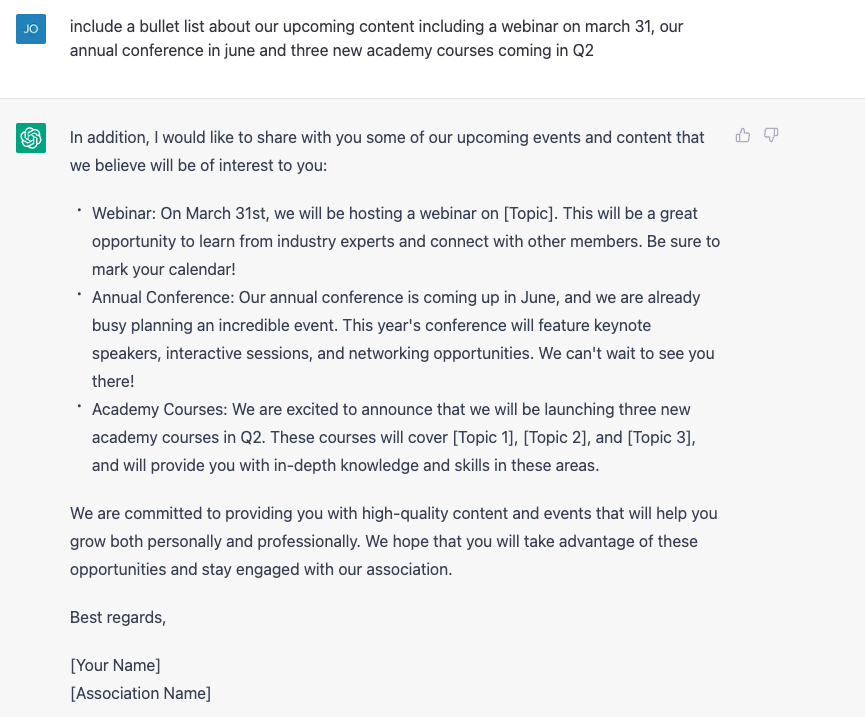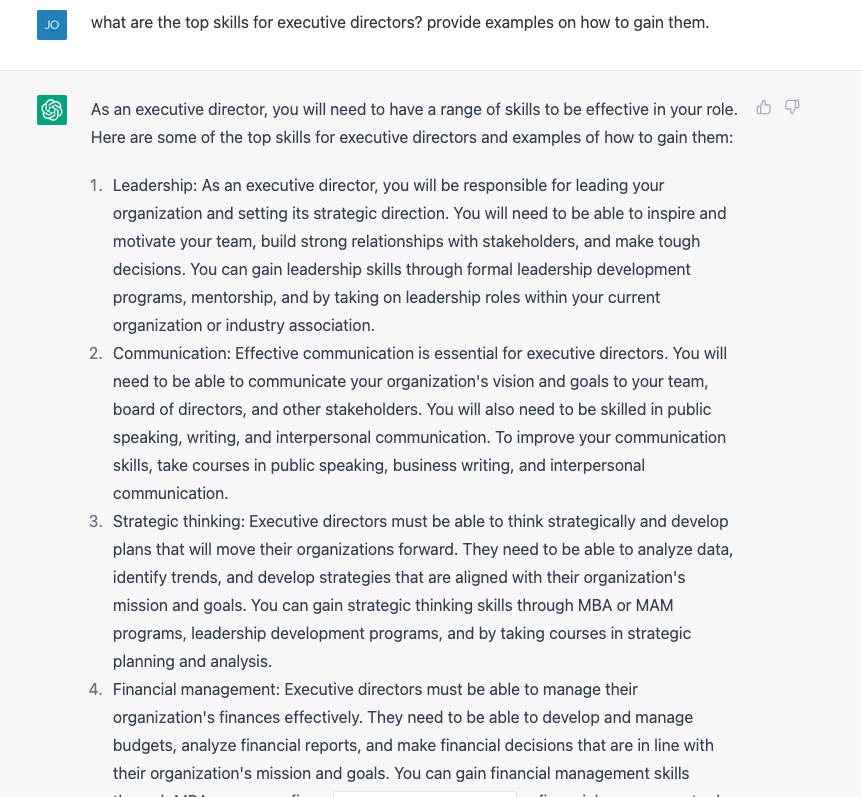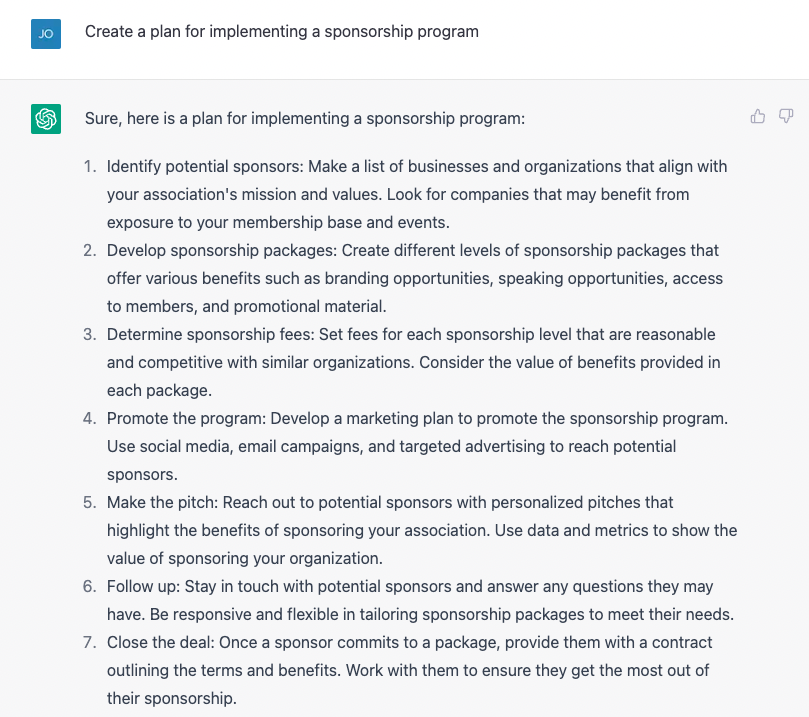As ChatGPT cruises past 100 million monthly users, it’s clear that AI-generated content is a powerful tool that’s here to stay. Today, organizations use it to write blogs, social media posts and marketing campaigns for conferences and webinars.
However, getting past the basic outputs to generate content useful to your association can sometimes take time and effort.
The solution? Improving your prompts to get exactly what you need.
Experimenting with ChatGPT
Before diving into ChatGPT prompts, it’s important to have a little background on the tool.
ChatGPT is an artificial intelligence language model developed by OpenAI. It’s trained on vast amounts of text data (current up to 2021) and uses advanced algorithms to generate human-like responses.
You can use ChatGPT for a variety of tasks, including:
- Providing customer support: It can answer common questions, help customers troubleshoot issues and provide information about products and services.
- Writing: You can use ChatGPT to help you write articles, essays or even fiction. Simply provide it with a prompt, and it will generate text based on that prompt.
- Recommending products: If you are looking for a specific product, ChatGPT can help you find the best options based on your preferences and needs.
The Power of Prompts
While ChatGPT – and most AI tools, for that matter – offer plenty of functionality, they have one consistent limitation. Their responses are only as good as your prompts and background information.
So how do you get better results? Here are four tips to improve your ChatGPT prompts.
- Be specific: Use clear and specific language in your prompts to ensure that ChatGPT understands exactly what you’re asking for. For example, don’t simply say write a letter to our members. Instead, ask it to write a letter to members whose membership is about to renew and highlight some of your organization’s upcoming courses and events.
- Consider different perspectives: Anticipate how different people might interpret your prompts and adjust them accordingly. Adding modifiers like “explain this to someone new to the organization” or “write in a more friendly tone,” ChatGPT can tailor your language to be inclusive and accessible.
- Use relevant keywords: Associations looking to ensure their AI-generated content is SEO optimized or at least targeted to a specific audience should include relevant keywords in your prompts. For example, if you’re writing a blog post about work culture, you can ask it to include terms like “burnout,” “great resignation” and “retention” in your instructions.
- Test and refine: Finally, and more importantly, keep experimenting and adding details to each iteration. If you’re not happy with the response you’ve gotten from ChatGPT, try things like asking for examples, bulleted lists or changing the tone. Also, leverage user feedback and analytics (are some blogs getting more traffic than others?) to refine your prompts and improve the accuracy and usefulness of ChatGPT's responses.
3 ChatGPT Prompts to Get Started
So, you’re on board with trying ChatGPT but not sure where to start? We experimented with a few prompts that could be a perfect starting point.
1. An onboarding message for a new member
Welcome letters should be a routine part of your association onboarding process. And while you may have a templatized version, when was the last time you updated it? With a simple prompt like “Write a welcome letter for new members of [association name],” you can get some new content for a refresh.
And if you’re looking for unique ways to highlight upcoming programming, add details.

2. Career advice for your association dream job
Career advancement is often top of mind for many association professionals. And while you can work with a mentor or ask your leaders for advice, sometimes you just want to explore independently. Try experimenting with “how do I get hired as an association [role]?”
ChatGPT may provide some general details about the types of degrees required, where to find jobs and the interview process, but what happens when you want to get serious about landing one of these jobs? Get specific with your needs and provide details.

3. Generating new non-dues revenue ideas
Non-dues revenue is often a top priority for associations. And while you can use ChatGPT to brainstorm some ideas – “give me a list of 10 non-dues revenue ideas for [association name]” – it can also be a helpful tool for implementing an actual plan of action.
For example, let’s say your association’s non-dues revenue idea is a sponsorship program. ChatGPT can give you a general idea of the steps needed to make it happen.

Leveraging AI Tools in Your Association
The world of AI tools is vast, but ChatGPT can be a fun place to start for many associations. While it doesn't replace experience and teamwork within your organization, it can be an excellent tool for overcoming that initial ideation hump.
Of course, learning how to manipulate your prompts will quickly become a necessity – especially if you want content you can implement. Whether that means asking for more details, starting with lists or changing the tone or perspective (i.e., friendly or for c-suite executives), it can help foster better results.
And finally, remember that these tools are an effective way to augment your staff’s skills, not a replacement. So while there may still be the need for editing, using AI-generated content can help reduce the time it takes to write a letter, for example, giving your staff more time to focus on their core responsibilities.

February 23, 2023


